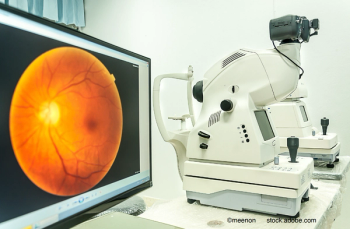
Understanding genetic risk factors for AMD
A better understanding of how genetic risk factors influence the trajectory of age-related macular degeneration may be key to solving the puzzles of this disease. Ocular tissue research may play a role in that process.
Take-home
A better understanding of how genetic risk factors influence the trajectory of age-related macular degeneration may be key to solving the puzzles of this disease. Ocular tissue research may play a role in that process.
Dr. MullinsEye on Research By Robert F. Mullins, MS, PhD
The clinical community now has some very effective anti-vascular endothelial growth factor drugs for managing neovascular membranes in age-related macular degeneration (AMD). But there is little recourse for patients with geographic atrophy, in part because we do not yet understand what causes retinal cells to become damaged and die in the dry form of AMD.
Ideally, one would like not only to be able to treat both forms of AMD, but to intervene earlier in the disease, before there is irreparable damage.
A better understanding of how genetic risk factors influence the trajectory of AMD may be key to solving the puzzles of this disease. Already, many millions of dollars have been spent in identifying genetic risks for AMD, and with some very positive results. We now have a long list of genetic variations associated with AMD.
But little is known about how these polymorphisms or mutations increase risk or how they might affect disease severity or progression.
My laboratory is exploring how genetic variations might predispose the choriocapillaris endothelial cells to become abnormally activated in wet AMD or damaged in dry AMD, in order to determine how we can arrest these processes.
We have been able to study many of these genetic variations in mice. But one of the major risk factors for AMD is a haplotype on chromosome 10q that includes the ARMS2 gene. This interesting gene, unfortunately, has no ortholog outside primates.
To study the biochemistry of ARMS2-that is, how the ARMS2 risk factor changes the behavior of cells and expression of genes in the macula-we need to analyze cellular proteins and ribonucleic acid (RNA) from human retinal tissue. Unlike DNA, which is extremely stable and can be taken from Neanderthal bones or 4,000-year-old mummies, RNA survives only for a few hours after death, so it is challenging to study.
Once obtained, though, we can use commercially available chips or deep sequencing to relatively easily study the expression of 25,000 genes all at once.
AMD and complement system
We know that genetic variations in the complement factor H (CFH) gene are associated with an elevated risk of early AMD, geographic atrophy, and choroidal neovascularization (Figure 1).
The complement system is protective in humans-it helps kill harmful fungi and microbes and prepare them for removal-but when it goes awry it can quickly overwhelm and damage “bystander” cells. Data from human genetics, histopathology, and animal models have long suggested a major role for the complement system in the development of AMD.
CFH itself is an inhibitor that works to keep the complement system in check. What we suspect is that in eyes with a polymorphism that prevents CFH from functioning correctly, the complement system starts destroying retinal cells.
In seeking to figure out where to intervene in the complement pathway, we have been studying the membrane attack complex (MAC). The MAC is a funnel shaped, cell-perforating complex of proteins. In aging human eyes, the MAC is deposited around the choriocapillaris (Figure 1).
Most of it is in the choroid1 and there is more MAC in the macular region of the retina than in the extramacular regions.2 We sought to determine whether eyes from donors with the high-risk genotype-with two copies of the AMD-associated polymorphism-exhibited altered levels of MAC in the choroid compared with eyes with a low-risk genotype.
To accomplish this, proteins were extracted from the retinal pigment epithelium (RPE) and choroid of 18 donors (10 low-risk and 8 high-risk) and levels of MAC were assessed. We found that MAC levels were 69% higher in the high-risk eyes than in the low-risk eyes (p < 0.05), independent of whether the eyes showed signs of early AMD.3
This is evidence that high-risk CFH genotypes may affect AMD risk by increased deposition of MAC around the aging choriocapillaris, thereby leading to increased injury and death of choriocapillaris endothelial cells.
Research into the complement system represents just one of the ways that human donor eyes can be used to make new discoveries about retinal cell biology. The hope is that donor tissue can also be used to help translate cell biology findings into new therapeutic approaches.
For example, if complement genes-or some other factor that we have yet to identify-are always present at too high a level in eyes with early AMD, perhaps a drug that alters levels of that genetic factor can protect the cells.
Ongoing need for tissue
Another use for donor tissue lies in the area of therapeutic stem cell research.
We now understand that choroidal abnormalities-including choriocapillaris endothelial cell loss-occur very early in AMD, which suggests that the utility of injecting RPE stem cells on top of damaged or dead choroidal vascular cells may not be very high. Donor tissue will be needed to both guide the stem cell experiments in different disease states and to help us understand how to optimize delivery of stem cells so they do help to preserve vision.
Gathering donor tissue that is fresh enough and of high enough quality to be useful for research requires a tremendous and well-coordinated effort. We have been fortunate to be able to work closely with the Iowa Eye Bank to collect more than 1,300 donor eyes since 2004. One of our lab members is always on pager duty so that tissue can be received and processed at any time of the day or night.
The donor eyes are photographed (Figure 2), dissected, and preserved in a standardized fashion to maximize their value to a range of scientists at the University of Iowa Institute for Vision Research studying AMD, glaucoma, diabetic retinopathy, and other conditions.
This is an unusual commitment, both from the eye bank and the university. Most eye banks around the country have not been as focused on providing research tissue within short death-to-preservation times, perhaps because end users have also not been as willing to accept tissue at inconvenient times. But with organizations like the Iowa Lions Eye Bank in Iowa City and the Lions Eye Institute for Transplant and Research in Tampa, which says it dedicates about 40% of its tissue to research, we can make tremendous progress in understanding genetic risk factors for AMD.
The gift of ocular tissue is such a valuable one. It is very exciting that through the generosity of donors and their families, we not only can transplant corneas to help individuals see, but also conduct research that will one day help millions of people avoid vision loss from AMD.
Robert F. Mullins, MS, PhD, is associate professor of ophthalmology and visual sciences, associate professor of molecular physiology and biophysics, and the Hansjoerg EJW Kolder, MD, PhD, Professor in Best Disease Research at the University of Iowa Carver College of Medicine and the University’s Institute for Vision Research. Readers may contact him at
References
1. Seth A, Cui J, To E, et al. Complement-associated deposits in the human retina. Invest Ophthalmol Vis Sci. 2008;49:743-750.
2. Hageman GS, Anderson DH, Johnson LV, et al. A common haplotype in the complement regulatory gene factor H (HF1/CFH) predisposes individuals to age-related macular degeneration. Proc Natl Acad Sci USA 2005;102:7227-7232.
3. Mullins RF, Dewald AD, Streb LM, et al. Elevated membrane attack complex in human choroid with high-risk complement factor H genotypes. Exp Eye Res. 2011;93:565-567.
(Figure 1) Immunofluorescence analysis of an eye with neovascular AMD shows abnormal blood vessels (red) that have invaded Bruch’s membrane. Green fluorescence shows the distribution of complement complexes in this histology sample.
(Figure 2) Gross photo of a human eye prior to genotyping and histology preparation. (Images courtesy of Robert F. Mullins, MS, PhD)
About this series
Eye on Research is a quarterly series of articles highlighting cutting-edge ophthalmic research with the potential to have a significant effect on vision and ocular health worldwide. The series is supported by the Lions Eye Institute for Transplant and Research Inc. (LEITR), a nonprofit organization dedicated to the recovery, evaluation, and distribution of eye tissue for transplantation, research, and education. Located in Tampa, FL, LEITR is the only combined eye bank and ocular research center in the world. LEITR provides fresh donor globes, corneas, lenses, trabecular meshwork, and other tissues from diseased and healthy human eyes, often within 4 to 6 hours of death, to researchers for immediate use in their own labs or in its onsite research facility. For more information, contact
Newsletter
Keep your retina practice on the forefront—subscribe for expert analysis and emerging trends in retinal disease management.















































